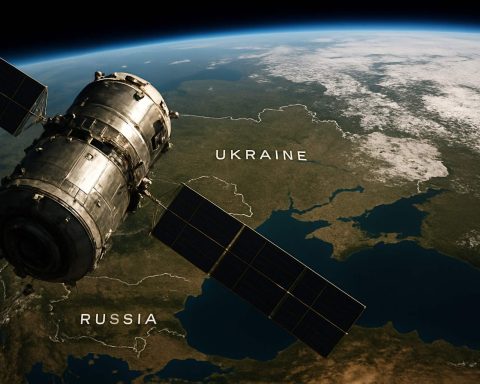Space Showdown: The Transformative Role of Military Satellites in the Ukraine-Russia War
- Evolving Dynamics of Military Satellite Deployment
- Emerging Innovations in Space-Based Defense Systems
- Key Players and Strategic Alliances in Military Satellite Operations
- Projected Expansion and Investment in Defense Satellite Capabilities
- Geopolitical Hotspots and Regional Satellite Utilization
- Anticipated Developments in Space Warfare and Surveillance
- Barriers, Risks, and Strategic Openings in Military Satellite Use
- Sources & References
“Tech News Today: Foldable Phones, AI Video, Interstellar Visitors, and the End of Exclusivity The technology landscape is shifting rapidly, with breakthroughs in hardware, AI, astronomy, and the gaming industry.” (source)
Evolving Dynamics of Military Satellite Deployment
The ongoing Ukraine-Russia war has thrust military satellites into the spotlight, underscoring their pivotal role in modern warfare. Both sides, along with their allies, are leveraging space-based assets for intelligence, surveillance, reconnaissance (ISR), communications, and targeting, fundamentally altering the conflict’s dynamics.
Ukraine, lacking its own military satellite constellation, has relied heavily on Western commercial and government satellites. Companies like Maxar Technologies and Planet Labs have provided high-resolution imagery, enabling Ukrainian forces to monitor Russian troop movements, assess battlefield damage, and plan counteroffensives. The U.S. and European governments have also supplied critical geospatial intelligence, enhancing Ukraine’s situational awareness.
Perhaps most transformative has been the use of SpaceX’s Starlink satellite internet. Since the war’s outset, over 42,000 Starlink terminals have been delivered to Ukraine, providing resilient, decentralized communications even in contested or infrastructure-damaged areas. This connectivity has proven vital for command and control, drone operations, and civilian communications, despite periodic disruptions and Russian jamming attempts.
Russia, meanwhile, has deployed its own military satellites for ISR and communications, though its capabilities are reportedly less advanced and more vulnerable to Western countermeasures. Russian forces have also targeted Ukrainian and Western satellite links with electronic warfare, attempting to jam or spoof signals. The Viasat cyberattack at the war’s outset, attributed to Russian actors, disrupted satellite communications across Europe, highlighting the vulnerability of space assets to cyber operations.
- ISR and Targeting: Satellite imagery has enabled precision strikes and rapid response to battlefield developments.
- Communications: Satellite internet has ensured uninterrupted command and control, even under heavy attack.
- Electronic Warfare: Both sides are engaged in a cat-and-mouse game of jamming, spoofing, and cyberattacks targeting space-based systems.
The Ukraine-Russia conflict has thus become a proving ground for the integration of military and commercial satellites in warfare, setting precedents for future conflicts and accelerating the militarization of space (CSIS).
Emerging Innovations in Space-Based Defense Systems
The ongoing Ukraine-Russia war has thrust military satellites into the spotlight, demonstrating their pivotal role in modern warfare. Both sides, along with their allies, are leveraging space-based assets for intelligence, surveillance, reconnaissance (ISR), and communications, fundamentally altering the conflict’s dynamics.
Ukraine, with support from Western nations, has gained unprecedented access to commercial and military satellite imagery. Companies like Planet Labs and Maxar Technologies have provided high-resolution images, enabling Ukrainian forces to track Russian troop movements, identify targets, and assess battlefield damage in near real-time. This open-source intelligence has been widely shared with the public and media, increasing transparency and countering disinformation.
On the communications front, SpaceX’s Starlink satellite internet has been a game-changer for Ukraine. Starlink terminals have ensured resilient, decentralized communications for both military and civilian use, even as terrestrial networks have been disrupted by Russian attacks. As of early 2024, over 42,000 Starlink terminals were reportedly active in Ukraine (Politico).
Russia, meanwhile, has relied on its own military satellite constellations, such as the GLONASS navigation system and reconnaissance satellites, to coordinate operations and guide precision munitions. However, Western sanctions and export controls have reportedly hampered Russia’s ability to replenish and upgrade its space assets (Defense News).
The conflict has also highlighted the vulnerability of space-based systems. Both sides have engaged in electronic warfare, attempting to jam or spoof satellite signals. There are growing concerns about the potential for anti-satellite (ASAT) weapons to escalate the conflict into space (C4ISRNET).
- ISR and targeting: Commercial and military satellites provide real-time intelligence and targeting data.
- Resilient communications: Satellite internet ensures command and control continuity.
- Electronic warfare: Jamming and spoofing threaten satellite reliability.
- Strategic vulnerability: The risk of ASAT attacks is rising.
In summary, the Ukraine-Russia war is a proving ground for space-based defense innovations, underscoring the strategic importance—and fragility—of military satellites in 21st-century conflicts.
Key Players and Strategic Alliances in Military Satellite Operations
The Ukraine-Russia war has thrust military satellite operations into the global spotlight, highlighting their pivotal role in modern warfare. Both sides, along with their allies, have leveraged space-based assets for intelligence, surveillance, reconnaissance (ISR), and communications, fundamentally altering the conflict’s dynamics.
- United States and NATO Allies: The U.S. has provided Ukraine with extensive satellite support, including commercial imagery from companies like Maxar Technologies and Planet Labs. These images have been crucial for tracking Russian troop movements and verifying battlefield events. The U.S. military’s Space Force has also coordinated secure communications and navigation support for Ukrainian forces.
- Commercial Partnerships: SpaceX’s Starlink has played a transformative role by providing resilient internet connectivity to Ukraine, countering Russian attempts to disrupt communications. As of early 2024, over 42,000 Starlink terminals have been delivered to Ukraine, supporting both military and civilian operations (Reuters).
- Russia’s Military Satellite Capabilities: Russia relies on its GLONASS navigation system and a network of military satellites for ISR and secure communications. However, Western sanctions and export controls have reportedly hampered Russia’s ability to replenish and upgrade its satellite fleet (Defense News).
- Strategic Alliances: The war has accelerated collaboration between Western governments and private space companies. The NATO Space Centre in Germany has coordinated satellite data sharing among allies, while the European Union has increased funding for secure satellite communications through its IRIS² initiative.
In summary, the Ukraine-Russia conflict has underscored the strategic value of military satellites and the importance of public-private alliances. The ability to access, share, and protect space-based assets is now a decisive factor in modern warfare, shaping both battlefield outcomes and the future of global security.
Projected Expansion and Investment in Defense Satellite Capabilities
The ongoing Ukraine-Russia war has thrust military satellite capabilities into the global spotlight, underscoring their pivotal role in modern warfare and accelerating projected expansion and investment in defense satellite infrastructure. Both sides, as well as their international allies, have leveraged space-based assets for intelligence, surveillance, reconnaissance (ISR), and secure communications, fundamentally altering the conflict’s dynamics.
Ukraine’s effective use of commercial and military satellites—most notably SpaceX’s Starlink constellation—has enabled resilient battlefield communications and real-time intelligence sharing, even amid Russian attempts to jam or disrupt terrestrial networks. According to the New York Times, Starlink terminals have become a “lifeline” for Ukrainian forces, facilitating command and control, drone operations, and targeting.
Meanwhile, Russia has intensified its own investment in military satellite programs, seeking to bolster its electronic warfare and anti-satellite (ASAT) capabilities. The conflict has seen increased use of Russian satellites for ISR and navigation, as well as reported attempts to jam or spoof GPS signals used by Ukrainian and allied forces (Reuters).
This “space showdown” has prompted a surge in global defense satellite spending. The U.S. Department of Defense requested $33.3 billion for space programs in its 2024 budget, a 15% increase over the previous year, with a focus on resilient satellite constellations and rapid launch capabilities (SpaceNews). European nations are also accelerating investments: the European Union announced a €2.4 billion plan for its own secure satellite communications system, IRIS², in response to the war’s lessons (Euronews).
- Commercial-military partnerships are expanding, with companies like Maxar and Planet Labs providing high-resolution satellite imagery to support Ukrainian operations (BBC).
- Resilience and redundancy are now top priorities, driving investment in proliferated low-Earth orbit (LEO) constellations to mitigate the risk of ASAT attacks.
- Electronic warfare countermeasures are being rapidly developed to protect satellite links from jamming and cyber threats.
In summary, the Ukraine-Russia war has catalyzed a new era of defense satellite expansion, with nations and private industry racing to secure space superiority and ensure the resilience of critical military infrastructure.
Geopolitical Hotspots and Regional Satellite Utilization
The ongoing Ukraine-Russia war has thrust military satellite technology into the global spotlight, fundamentally altering the nature of modern conflict. Both sides, along with their allies, are leveraging space-based assets for intelligence, surveillance, reconnaissance (ISR), and communications, making the war a real-time case study in the strategic value of satellites.
- ISR and Targeting: Ukraine has benefited significantly from Western commercial and military satellite imagery. Companies like Planet Labs and Maxar Technologies have provided high-resolution images, enabling Ukrainian forces to track Russian troop movements, identify equipment concentrations, and plan counteroffensives. The U.S. National Reconnaissance Office (NRO) and other agencies have also supplied critical intelligence, though details remain classified.
- Communications and Resilience: The rapid deployment of SpaceX’s Starlink terminals has been a game-changer for Ukraine, providing resilient, decentralized internet access even as terrestrial infrastructure is targeted. As of early 2024, over 42,000 Starlink terminals are reportedly in use in Ukraine, supporting both civilian and military communications (Politico).
- Electronic Warfare and Countermeasures: Russia has attempted to jam and disrupt satellite communications, deploying sophisticated electronic warfare systems. However, the adaptability of low-Earth orbit (LEO) constellations like Starlink has made sustained disruption difficult (New York Times).
- Escalation and Space Security: The conflict has raised concerns about the vulnerability of satellites to anti-satellite (ASAT) weapons and cyberattacks. In 2022, a cyberattack on the Viasat KA-SAT network disrupted communications across Europe, highlighting the risks to space infrastructure in wartime.
In summary, the Ukraine-Russia war has demonstrated that control and protection of space assets are now central to military strategy. The conflict is accelerating investment in satellite technology, hardening of space infrastructure, and the development of new doctrines for space-enabled warfare (CSIS).
Anticipated Developments in Space Warfare and Surveillance
The ongoing Ukraine-Russia war has thrust military satellites into the spotlight, demonstrating their pivotal role in modern conflict. Both sides, as well as their allies, are leveraging space-based assets for surveillance, communication, navigation, and targeting, fundamentally altering the dynamics of warfare.
Satellite Surveillance and Intelligence Gathering
- Real-Time Intelligence: Western commercial and military satellites have provided Ukraine with near real-time imagery and signals intelligence. Companies like Planet Labs and Maxar Technologies have supplied high-resolution images, enabling Ukrainian forces to track Russian troop movements, identify supply lines, and assess battlefield damage.
- Electronic Intelligence: The U.S. and NATO have deployed advanced satellites capable of intercepting Russian communications and radar emissions, providing critical situational awareness (The New York Times).
Satellite Communications and Navigation
- Starlink’s Role: SpaceX’s Starlink satellite constellation has been instrumental in maintaining Ukrainian command and control, especially after Russian attacks on terrestrial infrastructure. As of early 2024, over 42,000 Starlink terminals have been delivered to Ukraine (Reuters).
- GPS and Jamming: Both sides have attempted to jam or spoof GPS signals, highlighting the vulnerability of satellite navigation systems in contested environments (BBC).
Counterspace Operations and Escalation Risks
- Anti-Satellite Threats: Russia has demonstrated anti-satellite (ASAT) capabilities, raising concerns about the potential for escalation into space warfare. In 2021, Russia destroyed one of its own satellites in a test, creating thousands of debris pieces (NASA).
- Cyber and Electronic Attacks: Both sides have targeted satellite ground stations and communication links with cyberattacks, as seen in the Viasat hack at the war’s outset.
As the conflict continues, the integration of military satellites into battlefield operations is expected to deepen, with new technologies and countermeasures shaping the future of space warfare and surveillance.
Barriers, Risks, and Strategic Openings in Military Satellite Use
The Ukraine-Russia war has thrust military satellite technology into the global spotlight, revealing both the transformative power and the inherent vulnerabilities of space-based assets in modern conflict. The conflict has become a proving ground for the integration of commercial and military satellite capabilities, with significant implications for future warfare and international security.
- Barriers: One of the primary barriers in leveraging military satellites is the risk of signal jamming and cyberattacks. Russia has actively targeted satellite communications, attempting to disrupt Ukrainian command and control by jamming GPS and satellite internet services such as Starlink. Additionally, the high cost and complexity of launching and maintaining secure satellite constellations limit access for many nations, creating a technological divide.
- Risks: The reliance on satellites introduces new vulnerabilities. Anti-satellite (ASAT) weapons, electronic warfare, and cyber intrusions threaten the integrity of space assets. In 2022, a cyberattack on Viasat’s KA-SAT network disrupted communications across Ukraine and parts of Europe, highlighting the susceptibility of even commercial satellites to state-sponsored attacks (BBC). The potential for escalation into space warfare raises concerns about debris generation and the long-term sustainability of the orbital environment.
- Strategic Openings: Despite these risks, the war has demonstrated the strategic value of rapid satellite deployment and commercial partnerships. Ukraine’s use of commercial imagery from companies like Maxar and Planet Labs has enabled real-time intelligence and targeting, leveling the playing field against a technologically superior adversary. The agility of commercial providers, combined with the resilience of proliferated low-Earth orbit (LEO) constellations, offers a blueprint for future conflicts.
In summary, the Ukraine-Russia war underscores the dual-edged nature of military satellite use: while offering unprecedented situational awareness and communication, these assets are increasingly contested and vulnerable. The conflict is accelerating innovation in satellite resilience, cybersecurity, and public-private collaboration, setting new precedents for the role of space in warfare (CNAS).
Sources & References
- Space Showdown: How Military Satellites Are Shaping the Ukraine‑Russia War
- Maxar Technologies
- Planet Labs
- Maxar
- CSIS
- Politico
- GLONASS navigation system
- Defense News
- C4ISRNET
- GLONASS
- Euronews
- SpaceNews
- BBC
- NASA
- CNAS










